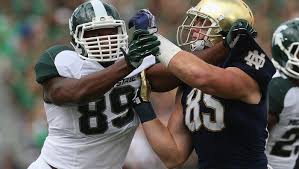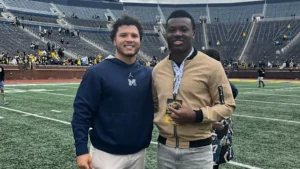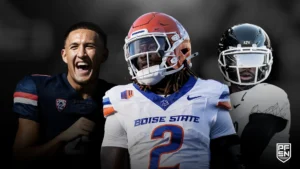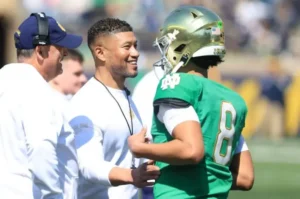
Freshman Cornerbacks Standing Out in College Football
In the ever-evolving world of college football, cornerbacks play one of the most pivotal roles on the field. A cornerback is tasked with covering the opposing team’s wide receivers, often in high-pressure situations, while also being responsible for reading the opposing offense and making split-second decisions that can change the course of a game. With the increasing emphasis on passing attacks in modern football, cornerbacks are often the last line of defense against explosive plays.
While veteran cornerbacks usually draw the most attention, in recent years, a new wave of freshman cornerbacks has begun to make their mark on the college football landscape. These young players are not only earning significant playing time but also excelling at a position that typically requires maturity, experience, and a high football IQ. The trend of freshman cornerbacks standing out is not just a flash in the pan—it is becoming a consistent and growing phenomenon. But what makes these freshmen so successful? What are the challenges they face? And who are some of the standout freshman cornerbacks in recent years?
This article explores the emergence of freshman cornerbacks in college football, focusing on why they are succeeding, the pressures they face, and highlighting some of the standout performers who have impressed in their first seasons.
1. The Evolution of Cornerback Play
Before diving into the specific freshmen who have stood out, it’s important to understand how cornerback play has evolved over time and why young players are making an immediate impact.
Changes in Offensive Schemes
Over the past decade, offenses in college football have become more complex and pass-heavy. Quarterbacks are getting better, faster, and more accurate, while wide receivers are becoming bigger, stronger, and quicker. This shift has made the cornerback position even more demanding. Historically, cornerbacks needed to excel in man-to-man coverage, but the rise of zone schemes, RPOs (Run-Pass Options), and fast-paced offenses has necessitated a more versatile and quick-thinking player in the secondary.
As a result, cornerbacks are expected to have excellent footwork, high-level awareness, and the ability to read and react to plays almost instantaneously. College programs now rely on recruiting cornerbacks who can make an impact right away, which has led to more freshmen playing significant roles in the secondary.
Training and Development
In addition to the increased demand for versatile cornerbacks, training methods have improved drastically over the years. Today’s cornerbacks benefit from advanced training in speed, agility, and technique from a young age. High school programs are more sophisticated than ever, offering cornerbacks better coaching and the chance to develop the skills necessary to excel at the collegiate level. This development, combined with top-tier strength and conditioning programs at the collegiate level, means that freshmen are often entering college football more prepared than their predecessors.
2. The Challenges Freshman Cornerbacks Face
While the training and opportunities are better than ever, playing cornerback as a freshman is still one of the most difficult tasks in college football. Cornerbacks must quickly adapt to the speed of the game, as the talent they face is often much greater than what they experienced in high school. They also need to grasp a complex playbook and be able to communicate with their teammates in the secondary. Despite these challenges, many freshmen have risen to the occasion and played significant roles in their team’s success.
Speed of the Game
One of the biggest hurdles for any freshman player—especially a cornerback—is the speed of the game. The jump from high school to college football is monumental in terms of athleticism. At the college level, the difference in speed between a skilled wide receiver and a defensive back is often negligible, and freshmen have to quickly adapt to the increased tempo. For cornerbacks, the ability to react quickly to a quarterback’s release, the receiver’s route, and the ball in the air is crucial.
Mental and Physical Adjustment
Cornerbacks are often placed in high-pressure situations, especially when covering the opposition’s best receiver. For a freshman to not only survive but thrive in such situations requires an impressive mental fortitude. Freshmen must be able to read offenses and make split-second decisions, often without the benefit of years of experience. On top of that, they must adjust to the physicality of college football, as wide receivers and quarterbacks are typically much stronger and faster than what they saw in high school.
Navigating the Learning Curve
Cornerbacks are tasked with learning complicated defensive schemes that require quick adjustments. This is particularly challenging for freshmen who have to integrate themselves into a system they may have only had a limited amount of time to study. Being able to understand both man-to-man and zone concepts, as well as working in tandem with safeties and linebackers, is essential for success.
3. Why Are Freshman Cornerbacks Standing Out?
Despite these challenges, a growing number of freshman cornerbacks have stood out in recent seasons. So, what factors have contributed to their success?
Advanced Skill Development
As mentioned earlier, young cornerbacks are entering college football better prepared than ever. Many players have been trained by elite coaches and have access to high-end facilities throughout their high school years. This has led to more polished skills from the moment they step onto a college campus. Freshman cornerbacks are showing off refined footwork, the ability to read routes, and the ball skills required to make game-changing plays.
Impact of Early Playing Time
Today’s college football programs are more willing to throw freshmen into the fire, so to speak, than they ever were before. Coaches are less patient with waiting for players to develop before giving them meaningful minutes on the field. Many programs rely on early-playing freshmen, particularly in the secondary, as they look for immediate impact. This accelerated playing time allows freshmen to develop quickly by gaining real-game experience rather than being relegated to the sidelines or special teams.
Changing Attitudes Toward Freshman Development
In the past, the emphasis for most top programs was on player development over several years. However, this has changed in recent seasons, as programs have realized that freshmen, especially those with high football IQs and elite athleticism, can contribute immediately. The college football landscape has evolved into one where elite players are expected to contribute in their first year. Cornerbacks, in particular, benefit from being thrust into high-stakes situations early on, as it allows them to grow quickly and gain confidence.
4. Notable Freshman Cornerbacks of Recent Seasons
There have been several freshman cornerbacks in recent years who have impressed with their performances. These players have not only played important roles on their respective teams but have also been recognized nationally for their achievements.
1. Kool-Aid McKinstry (Alabama)
Kool-Aid McKinstry’s emergence as a freshman cornerback at Alabama in 2021 was a perfect example of a player making an immediate impact. McKinstry, a 5-star recruit, earned significant playing time for the Crimson Tide and quickly became one of the top cornerbacks in the SEC. His combination of speed, physicality, and ball skills allowed him to make plays in key moments, including in Alabama’s game against Georgia in the SEC Championship. McKinstry’s standout freshman season set the stage for what could be an elite career.
2. Eli Ricks (LSU / Alabama)
Eli Ricks entered LSU as one of the top cornerbacks in the nation and made an immediate impact as a freshman. His ability to lock down wide receivers, coupled with his ball-hawking skills, earned him numerous accolades in his freshman season. After transferring to Alabama, Ricks continued his development and was widely regarded as one of the top cornerbacks in college football. His early success exemplifies the growing trend of freshman cornerbacks contributing at a high level from day one.
3. Cory and Cormani McClain (Miami)
Cormani McClain, a 5-star recruit for the University of Miami, is another example of a young cornerback making waves early in his career. After committing to the Hurricanes, McClain earned praise for his fluid movement, exceptional speed, and ability to shadow elite wide receivers. His freshman year was highly anticipated by many, as he was expected to be a shutdown corner from the get-go.
4. Kamari Rogers (Miami)
Kamari Rogers was another standout cornerback for Miami, whose freshman season saw him perform well in a variety of defensive schemes. Rogers’ ability to play both physical and technical football allowed him to excel in his first season, contributing to a rapidly improving Hurricanes defense.
5. Conclusion: The Future of Freshman Cornerbacks
As college football continues to evolve, the role of freshman cornerbacks will only grow in importance. Coaches are placing more trust in young players to contribute right away, and cornerbacks, with their blend of athleticism, speed, and intelligence, are often among the most notable freshmen to make an immediate impact.
While the challenges are steep for any freshman stepping onto a college football field, cornerbacks are finding ways to excel. Whether through advanced skill development, immediate playing time, or the ability to adapt quickly to the college game, these young players are proving that they belong at the highest level. As more freshmen step up and take on key roles in their teams’ secondaries, the landscape of college football will continue to change, with cornerbacks playing an increasingly crucial role in the success of their teams.
The future of college football looks bright for these young cornerbacks, and their success as freshmen is a testament to the growing importance of the position and the readiness of today’s players. As we look ahead, expect to see even





